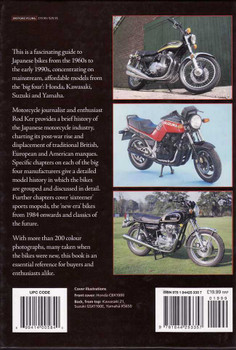Description
Author: Uli Cloesen, Harbound, 123 Pages, ISBN: 9781845845308, 1st Edition, December 2013
- The Nippon Chop - Chopper, Cruiser, Bobber, Trikes & Quads
Life would be boring without a touch of individuality, creativity and flair. This applies even more so to two-, three- or four-wheeled modes of transport. There has to be an emotional response, a feel-good trigger that engages us to build, ride or drive.
So, what triggered the invention of the 'bobber?' When US soldiers returned home after World War II, they wanted bikes more like the European ones they'd seen; motorcycles with less bulk than the homegrown varieties available. A bobber was created from o standard bike by 'bobbing,' or shedding weight, which usually involved scrapping the front fender and shortening the rear fender, with the intention of making a bike lighter and faster [NB: Not all countries allow the removal of fenders on bikes]. The look of a more minimalist design was also preferred to that of standard machines.
It wasn't until 1969, when American road movie Easy Rider, starring Peter Fonda, Dennis Hopper and Jack Nicholson, appeared that the term 'chopper' arrived on the scene. Motorcycle enthusiasts were inspied to modify their bikes in new ways, and began changing the angle of the front fork, reducing the size of the fuel tank, and adding ape hanger handlebars. To round it off, a slim front wheel and a fat rear tyre were added to the package.
The main difference between bobber and chopper bikes is that babbers are usually built around standard frames, while chopper frames are often cut and welded to suit. Bobbers also often lack chrome parts and long forks.
A 'cruiser' is a bike created in the style of American machines from the likes of Harley-Davidson or Indian. This segment of the motorcycle market is most popular in the US. The Big Four bike manufacturers (Honda, Kawasaki, Suzuki and Yamaha) all produced V-twin cruisers for this very important market.
The riding style on a cruiser typically entails a feet-forward position with an upright body. The low-slung design of this type of bike limits its cornering ability, and chopper motorcycles are considered cruisers in this context.
A 'trike' is in essence a three-wheeled motorcycle, carrying its rider and up to two passengers, depending on specification. For those who don't like the idea of riding a bike, but seek the same thrill of acceleration and speed, a trike which has the added safety of an extra wheel, could be the answer. In many countries you don't have to wear a helmet when riding a trike, because they can be registered like a car.
The 'quad' was introduced about three decades ago with the Honda US 90 - the first all-terrain vehicle (ATV). Less expensive to run and smaller and more manoeuvrable than a ute or tractor, with low-pressure tyres suited to soft ground, ATVs became essential on farms, and even as a means of mobility for the disabled. A new breed of quad has since evolved for road use, with high-performance engines and car-type chassis, and it's these that feature in this book.
Lastly, for any metric conversion needs, refer to www.metricconversions.org.
ACKNOWLEDGEMENTS
The author and publisher wish to acknowledge their debt to all who loaned material and photographs for this book. Thank you also to Honda, Kawasaki, Suzuki, and Yamaha for providing material.
You are welcome to contact us to have your Japanese-powered Chopper, Cruiser, Bobber, Trike or Quad considered for an updated edition of this book in the future.






















